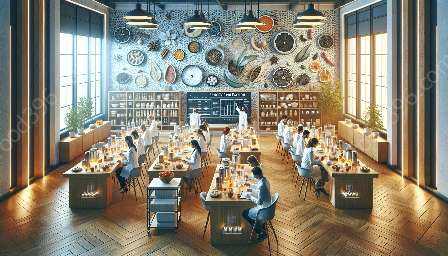Food is not only sustenance; it is also an experience that engages our senses and emotions. Understanding how we perceive and enjoy food is crucial in product development, culinary arts, and consumer satisfaction. This topic cluster delves into the world of hedonic testing, sensory evaluation, and culinology and explores their interconnections.
Hedonic Testing
Hedonic testing is a critical component of product development, marketing, and consumer satisfaction research. It focuses on understanding and quantifying the sensory and emotional responses that products evoke in consumers. By conducting hedonic tests, food scientists and researchers aim to measure and interpret the degree of pleasure or liking experienced by individuals when exposed to a product.
During a hedonic test, participants are presented with food or beverage samples and asked to evaluate their overall liking using a structured rating scale. This can range from simple preference ratings to more complex paired comparison or ranking methodologies. The results are then statistically analyzed to draw conclusions about consumer preferences, which can inform product formulation, packaging, and marketing strategies.
Relating Hedonic Testing to Sensory Evaluation
Hedonic testing is closely related to sensory evaluation, as both disciplines are concerned with understanding and measuring consumer responses to food products. While hedonic testing focuses on overall liking, sensory evaluation delves deeper into the specific sensory attributes of a product, such as appearance, aroma, taste, and texture.
Sensory evaluation employs trained panelists who use rigorous methodologies to quantify and describe the sensory properties of food and beverages. These evaluations provide detailed insights into the sensory characteristics that drive consumer preferences and guide product development. Through the integration of hedonic testing and sensory evaluation, researchers can build a comprehensive understanding of consumer preferences and the sensory attributes that contribute to positive hedonic responses.
The Role of Culinology
Culinology encompasses the fusion of culinary arts and food science to create innovative and market-ready food products. It emphasizes the marriage of culinary expertise with scientific principles, encompassing sensory evaluation and hedonic testing in product development. Culinologists apply their understanding of sensory attributes and consumer preferences to formulate products that offer desirable taste, texture, and overall sensory appeal.
By combining the knowledge from sensory evaluation and hedonic testing, culinologists can modify and optimize recipes, processing techniques, and ingredient selections to meet consumer demands. Additionally, they collaborate with marketing and research teams to position products effectively in the market, leveraging insights from hedonic testing to create appealing sensory experiences for consumers.
The Future of Hedonic Testing in Culinology
The evolution of hedonic testing in the context of culinology holds promising opportunities for the food industry. With advancements in technology, including virtual reality and neuroimaging, researchers can delve deeper into understanding the neurobiological and psychological mechanisms underlying hedonic responses to food. This can inform product innovation and marketing strategies, leading to the creation of highly enjoyable and satisfying food experiences for consumers.
Ultimately, the integration of hedonic testing, sensory evaluation, and culinology forms a powerful framework for delivering products that resonate with consumers on a sensory and emotional level. By understanding and leveraging the interplay between these areas, the food industry can thrive in creating products that not only nourish the body but also delight the senses and enrich the culinary experience.


